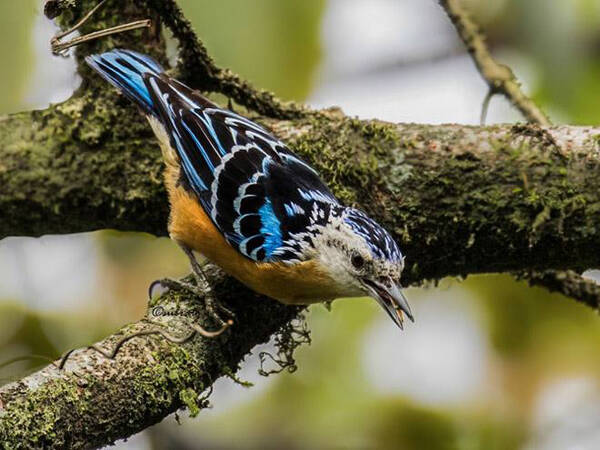Sitta formosa
IUCN
LCBasic Information
Scientific classification
- name:Sitta formosa
- Scientific Name:Sitta formosa,Beautiful Nuthatch
- Outline:Songbird
- Family:Passeriformes Songbirds Nuthidae
Vital signs
- length:16-21cm
- Weight:33-36g
- lifetime:No verification information
Feature
The head and upper back are bright black with purple-blue short sedge-like patterns; the upper wing coverts have white tip spots; the lower back is blue; the lower body is chestnut red
Distribution and Habitat
Distributed in Bhutan, Yunnan (Luchun), China, India (Assam), Lao People's Democratic Republic, Myanmar (west, southwest, northeast), Thailand, Vietnam (north).
It lives in tropical rainforests, monsoon forests, mountain evergreen broad-leaved forests and mixed forests. The habitat is 1300 meters to 2000 meters above sea level. The resource status is a rare species. The flora belongs to the Oriental realm, and it is endemic to the eastern Himalayan mountains.
Appearance
The head and upper back are bright black with purple-blue short thatch-like stripes; the upper wing coverts have white terminal spots; the lower back is blue; and the lower body is chestnut red. The male and female feathers are similar in color. The forehead, top of the head to the back of the neck and the upper back of the adult bird are bright black, covered with cobalt blue with purple or silvery white spear-like spots; the shoulder feathers, lower back, waist and tail coverts are bright blue; the small wings are small. The coverts are bright blue, and the rest of the coverts and flight feathers are black; the base of the middle coverts and large coverts are blue, and the tips are white; the inner flight feathers are edged in blue and white, forming obvious wing spots; the outer edges of the outer flight feathers are Bright blue; the central tail feathers are dark blue-gray with thick black shaft stripes; the rest of the tail feathers are black, with blue-gray outer edges and tips;
Details
Beautiful Nuthatch, also known as Beautiful Nuthatch in English, is a small songbird with no subspecies.

Beautiful Nuthatch usually lives in pairs or small groups on the tops of tall trees in valley forests. They mainly forage for insects under large trees with dense branches and leaves, including beetles, coleoptera and dipteran larvae. They also eat mosses, lichens, orchids and other epiphytes covering the trunks, and berries and seeds in winter. The movement of these birds is quite similar to that of other birds in the same genus, except that they move slower and their movements seem less certain. They are timid and their calls are low, weak and mellow.
In the mountainous areas of northeastern India, the breeding season of the nuthatches is from April to May. The nest is placed on a tree trunk 2-8 meters above the ground. Generally, large trees such as oak and rhododendron trees are chosen. The nest is low and lined with plants, which is relatively rough. The entrance of the nest is made of clay. Each nest lays 4-6 white eggs, which are sprinkled with dark red spots.
The main threats to the Nuthatch are forest loss, degradation and fragmentation due to plantation shifts, but more so local large-scale timber harvesting (e.g. logging of valuable conifers in central Laos and northern Vietnam), as well as overgrazing, burning and logging for timber (northeastern India). High hunting pressure in parts of its range is a significant threat.
Listed in the IUCN Red List of Threatened Species in 2016 ver 3.1 - Vulnerable (VU).
Listed in China's "National Key Protected Wildlife List" (February 5, 2021) Level 2.
Protect wildlife and eliminate game.
Maintaining ecological balance is everyone's responsibility!








